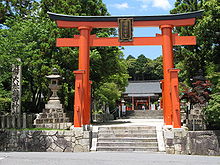
Tatsuta Shrine
Encyclopedia

Shinto
or Shintoism, also kami-no-michi, is the indigenous spirituality of Japan and the Japanese people. It is a set of practices, to be carried out diligently, to establish a connection between present day Japan and its ancient past. Shinto practices were first recorded and codified in the written...
shrine located in Sangō
Sango, Nara
is a town located in Ikoma District, Nara, Japan.As of October 1, 2007, the town has a population of 23,228 people, 11,079 males and 12,094 females and a density of 2,640 persons per km². There is a total of 9,281 households. The total area is 8.80 km²....
, Nara
Nara Prefecture
is a prefecture in the Kansai region on Honshū Island, Japan. The capital is the city of Nara.-History:The present-day Nara Prefecture was created in 1887, making it independent of Osaka Prefecture....
in Japan
Japan
Japan is an island nation in East Asia. Located in the Pacific Ocean, it lies to the east of the Sea of Japan, China, North Korea, South Korea and Russia, stretching from the Sea of Okhotsk in the north to the East China Sea and Taiwan in the south...
. The shrine is also known in Japanese (esp. formerly) as .
The Shrine became the object of Imperial patronage during the early Heian period
Heian period
The is the last division of classical Japanese history, running from 794 to 1185. The period is named after the capital city of Heian-kyō, or modern Kyōto. It is the period in Japanese history when Buddhism, Taoism and other Chinese influences were at their height...
. In 965, Emperor Murakami
Emperor Murakami
was the 62nd emperor of Japan, according to the traditional order of succession.Murakami's reign spanned the years from 946 to his death in 967.-Traditional narrative:...
ordered that Imperial messengers were sent to report important events to the guardian kami of Japan. These heihaku were initially presented to 16 shrines including the Tatsuta Shrine.
From 1871 through 1946, the Tatsuta Shrine was officially designated one of the , meaning that it stood in the first rank of government supported shrines.
See also
- List of Shinto shrines
- Twenty-Two Shrines
- Modern system of ranked Shinto ShrinesModern system of ranked Shinto ShrinesThe The The (sometimes called simply , was an organizational aspect of the establishment of Japanese State Shinto. This system classified Shinto shrines as either official government shrines or "other" shrines...
- Tatsuta MaruTatsuta MaruThe , also known as Tatuta Maru after 1938, was a Japanese ocean liner owned by Nippon Yusen Kaisha. The ship was built in 1927-1930 by Mitsubishi Shipbuilding & Engineering Co. at Nagasaki, Japan....

